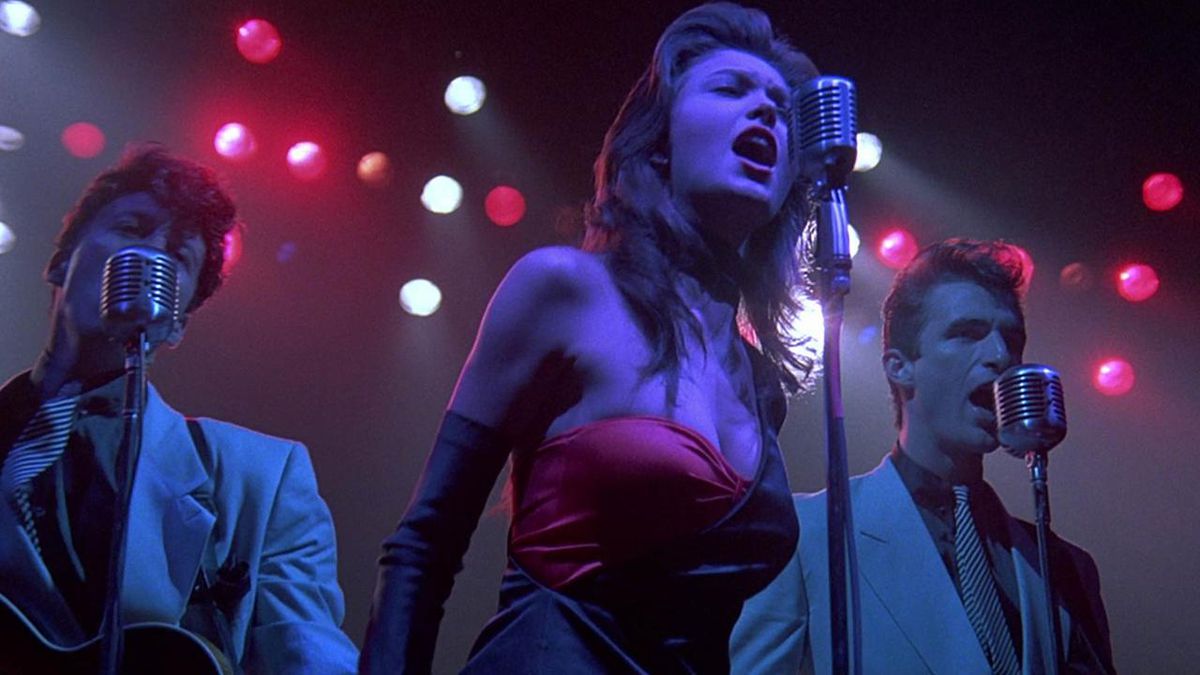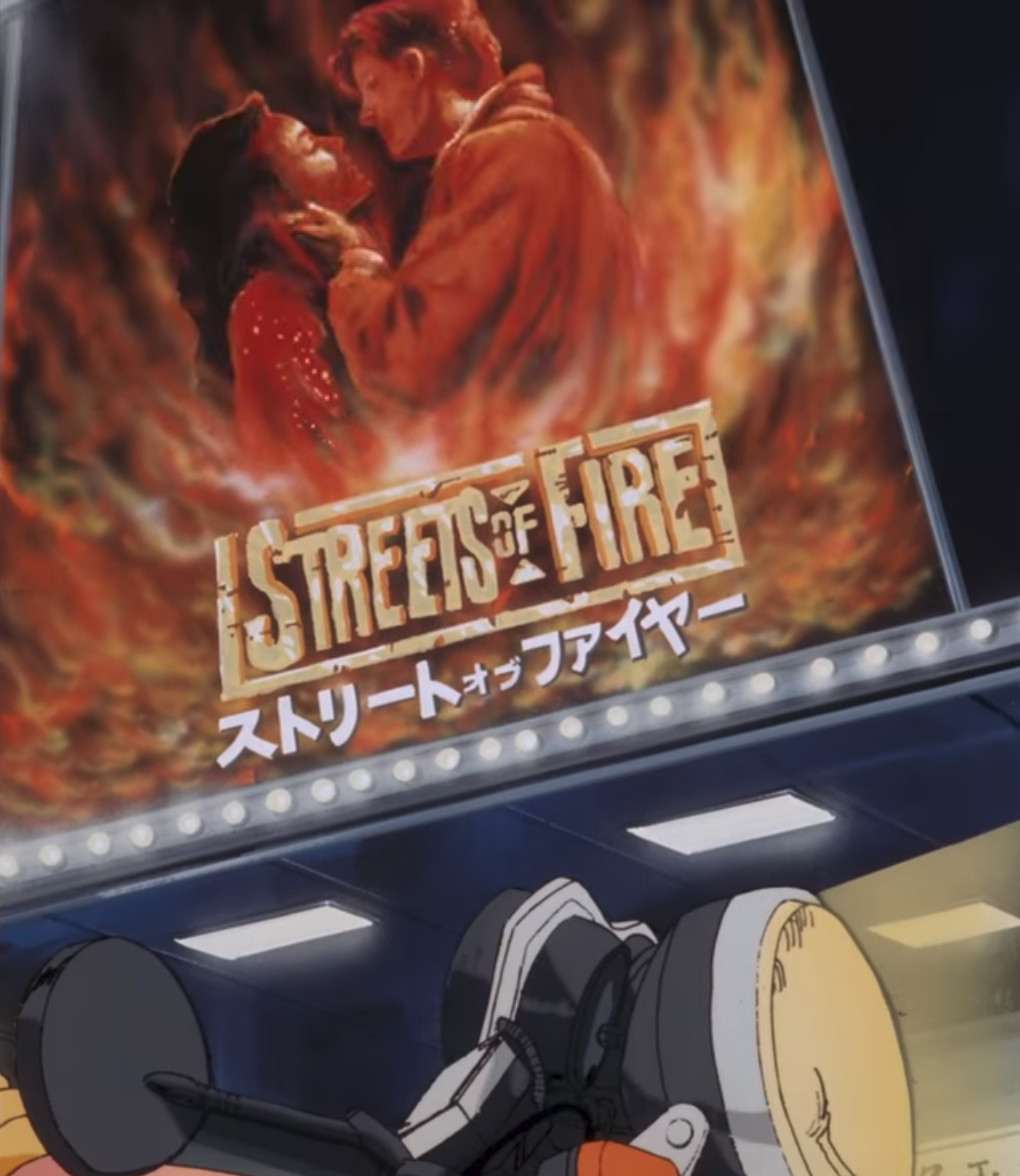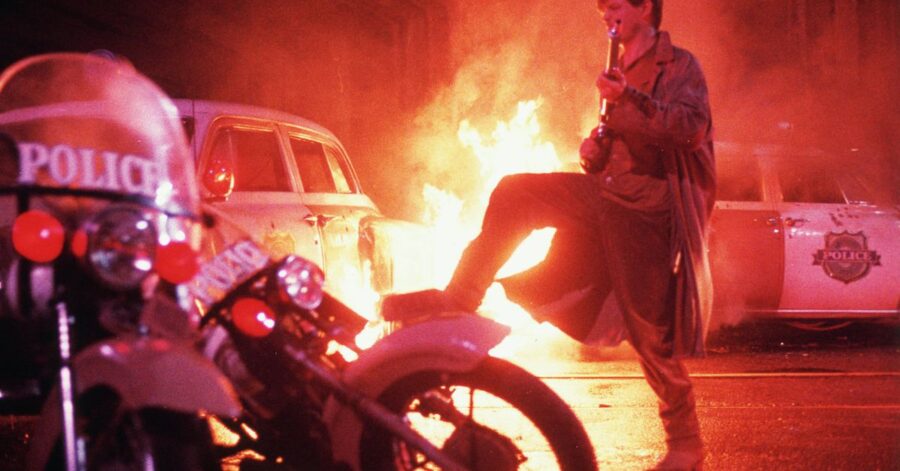The neo-noir rock musical Streets of Fire might be the most important cyberpunk movie that goes overlooked by fans of the genre. The self-styled “rock & roll fable” starring Michael Paré and Diane Lane was a big-swing from Walter Hill (Alien) and screenwriter Larry Gross’ following the massive success of their previous collaboration: 1982’s buddy cop action comedy 48 Hrs., starring Nick Nolte and Eddie Murphy. With the film recently added to Netflix, Streets of Fire may finally be recognized by American audiences as a source of inspiration for more popular iterations of its visuals.
The neo-noir musical follows the story of Ellen Aim (Lane), a rock ‘n roll singer who, after being kidnapped onstage by a nefarious biker (Willem Dafoe) and his gang of goons is rescued by her ex-boyfriend, the dashing wandering mercenary Tom Cody (Paré). The film feels like Grease by way of Escape from New York; an explosive, kitschy action drama filled with over-the-top brawls, a memorable neon-lit setting filmed on location between Lower Wacker Drive in Chicago and downtown Los Angeles, and a soundtrack filled with tracks written by the likes of Jim Steinman, Jimmy Iovine, and Stevie Nicks. The arguable peak of the film is the scene where Tom, having infiltrated the Biker’s hideout in an attempt to rescue Ellen, starts shooting the gas tanks of the gang’s motorcycles as a distraction before beating a hasty getaway with Ellen in tow.
Though Streets of Fire was a box-office bomb when it was released in 1984, grossing only $8 million in North America with a budget of over $14.5 million, its explosive action sequences, score, and memorable performances by Lane, Dafoe, and Rick Moranis as Ellen’s dweebish manager-slash-boyfriend Billy Fish have gained it a cult following. The film also has a somewhat understated, but no less substantial legacy as a visual and spiritual touchstone in the then-nascent speculative subgenre of cyberpunk.

Photo: Universal Pictures
When we look back on the earliest origin points of cyberpunk, most people point to the same foundational texts: William Gibson’s 1984 novel Neuromancer, Bruce Sterling’s Mirrorshades anthology, and Ridley Scott’s 1982 film Blade Runner. Despite being the visual ur-text for nearly every major cyberpunk film released in its way, Scott’s film is only retroactively acknowledged as one itself. The term “cyberpunk” was originally coined by Bruce Bethke’s novel of the same name, released just a year before Blade Runner’s premiere. It wouldn’t be until after the publication of Neuromancer and Mirrorshades that the term would later be adopted as the name for the subgenre itself.
Cyberpunk as we know it today was still in its infancy when Streets of Fire rolled around. Along with Blade Runner, films like 1981’s Escape from New York, 1982’s Burst City, and 1982’s Tron all helped establish the genre’s visual language. Streets of Fire emerged from out of this crop of defining films; an anachronistic rock and roll action romance set in “another time, another place,” drawing inspiration from the likes of Frances Ford Coppola’s Rumble Fish and Adrien Lynne’s Flashdance.
“[W]e had in mind one sentence inspired by George Lucas: ‘in a galaxy long ago,’ a futuristic past,” said Gross in an interview with Slash Film. “That was in our heads … there’s the past and there’s the future, sort of. So the big creative world decisions were music and then the other thing was, the other guru, “divinity,” behind Streets of Fire was John Hughes.”
Hughes’ teenage dramas also inspired Hill and Gross, but what they wound up with was a high school musical set in a neon-lit city where it’s almost always night and no one is over the age of 30. Streets of Fire’s anachronisms may have made it a hard sell in the States, but the film would nonetheless go on to achieve significant success when it later released in Japan. And this is where Streets of Fire’s muted legacy begins.
The story, characters, and music of Hill and Gross’ film would go on to influence two quintessential works of cyberpunk anime: the four-part anime OVA (original video animation) Megazone 23 and eight-part anime OVA Bubblegum Crisis. If the former’s premise of a young biker facing off against nefarious street gangs while uncovering the radical true nature of his world and composer Shiro Sagisu’s upbeat pop rock score weren’t already reminiscent of Streets of Fire’s own, the first episode of Megazone 23 literally opens with the protagonist going to see the actual film itself in theaters.

Photo: AnimEigo
The film’s impact on cyberpunk anime however is perhaps best known for inspiring the opening montage of Bubblegum Crisis’ first episode, with the scene of the fictional band “Priss and the Replicants,” fronted by series protagonist Priscilla Asagiri and an obvious reference to Blade Runner, performing in front of a packed nightclub. The song, “There’s a Hurricane Tonight,” is a clear homage to Streets of Fire’s own opening musical number “Nowhere fast,” replicating the same camera shots, lighting, and infectious pop rock sound of Diane Lane’s own performance as the film’s female lead Elle Aim.
The connections to better-known cyberpunk don’t stop there: Streets of Fire was also a formative influence on Mike Pondsmith’s Cyberpunk tabletop role-playing game, serving as a chief inspiration for the game’s “Rockerboy” player class, the character of Johnny Silverhand, and even the worldbuilding of the game’s videogame adaptation Cyberpunk 2077. “While Blade Runner is the most obvious go-to for the visual style, I think the original material is even more influenced by the little remembered Streets of Fire,” senior quest designer Patrick Mills said in an interview with Collider last year. “Noir films were an important influence on Cyberpunk 2077’s story, more even than the kind of sci-do you might expect. The themes of corruption, moral ambiguity, death, fate, and futility in our game are leaning on the work of the noir genre.”
Through the most unlikely of circumstances, Streets of Fire has continued to endure as a cult classic; a retro-contemporary noir-musical filled with memorable visuals and catchy rock ballads. Though having nothing to do with transhumanism or advanced technology, the film still hones in on that most enduring of cyberpunk locales: a dark, rain-slicked city rife with territorial disputes between oppressive law enforcement and lawless bikers and gangsters vying for control and power. It’s a fun movie; one you should definitely make the time to check out while it’s available.
Streets of Fire is available to stream on Netflix.
Polygon – All
Source link
Related Post:
- Video: Miyamoto’s Loveable But Forgotten Game Boy Classic – Mole Mania
- This week in PC Gaming: The Ascent, The Forgotten City, and cyberpunk kitties
- Alan Wake Remastered will see the Xbox 360 classic finally debut on PlayStation • Eurogamer.net
- Cyberpunk 2077's Allegedly "Satisfactory" Performance is a Classic Case of Fallen Standards
- EA now lets you see what’s in FIFA loot boxes before you buy them • Eurogamer.net
- You can now see inside some FIFA loot boxes before you buy
- Fire Emblem And 8 Other Nintendo Franchises That Need A TV Series – Feature
- The Forgotten City, a Skyrim mod gone rogue, has a release date for late July
- The Forgotten City Is Now Available For Digital Pre-order And Pre-download On Xbox One And Xbox Series X|S
- The Forgotten City’s Journey From a Mod to a Standalone Game
